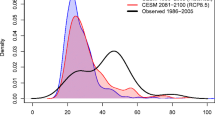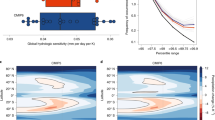Abstract
Using ensembles from the Community Earth System Model (CESM) under a high and a lower emission scenarios, we investigate changes in statistics of extreme daily temperature. The ensembles provide large samples for a robust application of extreme value theory. We estimate return values and return periods for annual maxima of the daily high and low temperatures as well as the 3-day averages of the same variables in current and future climate. Results indicate statistically significant increases (compared to the reference period of 1996–2005) in extreme temperatures over all land areas as early as 2025 under both scenarios, with statistically significant differences between them becoming pervasive over the globe by 2050. The substantially smaller changes, for all indices, produced under the lower emission case translate into sizeable benefits from emission mitigation: By 2075, in terms of reduced changes in 1-day heat extremes, about 95 % of land regions would see benefits of 1 °C or more under the lower emissions scenario, and 50 % or more of the land areas would benefit by at least 2 °C. 6 % of the land area would benefit by 3 °C or more in projected extreme minimum temperatures and 13 % would benefit by this amount for extreme maximum temperature. Benefits for 3-day metrics are similar. The future frequency of current extremes is also greatly reduced by mitigation: by the end of the century, under RCP8.5 more than half the land area experiences the current 20-year events every year while only between about 10 and 25 % of the area is affected by such severe changes under RCP4.5.





Similar content being viewed by others
References
Alexander LV et al (2006) Global observed changes in daily climate extremes of temperature and precipitation. J Geophys Res Atmos 111, D05109
Coles S (2001) An introduction to statistical modeling of extreme values. Springer, London
Collins M et al (2013) Long-term climate change: projections, commitments and irreversibility. In Climate Change 2013: The physical science basis. Contribution of working group I to the fifth assessment report of the Intergovernmental Panel on Climate Change [Stocker, T.F., et al. (eds.)]. Cambridge University Press, Cambridge, United Kingdom and New York, NY, USA
Donat MG et al (2013) Updated analyses of temperature and precipitation extreme indices since the beginning of the twentieth century: the HadEX2 dataset. J Geophys Res Atmos 118(5):2098–2118
Donat MG et al (2014) Consistency of temperature and precipitation extremes across various global gridded in situ and reanalysis data sets. J Clim 27:5019–5035
Fischer E, Schar C (2010) Consistent geographical patterns of changes in high-impact European heatwaves. Nat Geosci 3(6):398–403
Hosking JRM, Wallis JR (1997) Regional frequency analysis, an approach based on L-moments. Cambridge University Press, Cambridge
Hurrell JW et al (2013) The community earth system model: a framework for collaborative research. Bull Am Meteorol Soc 94:1339–1360
Kay J et al (2014) The community earth system model (CESM) large ensemble project: a community resource for studying climate change in the presence of internal climate variability. Bull Am Meteorol Soc. doi:10.1175/BAMS-D-13-00255.1
Kharin VV et al (2013) Changes in temperature and precipitation extremes in the CMIP5 ensemble. Clim Chang 119:345–357
Meehl GA, Tebaldi C (2004) More intense, more frequent and longer lasting heat waves in the 21st century. Science 305:994–997
Meehl GA et al (2013) Climate change projections in CESM1(CAM5) compared to CCSM4. J Clim 26:6287–6308
Pal J, Eltahir EAB (2015) Future temperature in southwest Asia projected to exceed a threshold for human adaptability. Nat Clim Chang. doi:10.1038/nclimate2833
Sillmann J et al (2013a) Climate extremes indices in the CMIP5 multimodel ensemble: part 1. Model evaluation in the present climate. J Geophys Res Atmos 118:1716–1733
Sillmann J et al (2013b) Climate extremes indices in the CMIP5 multimodel ensemble: part 2. Future climate projections. J Geophys Res Atmos 118:2473–2493
Tebaldi C, Arblaster JM (2014) Pattern scaling: its strengths and limitations, and an update on the latest model simulations. Clim Chang 122:459–471
VanVuuren DP et al (2011) Representative concentration pathways: an overview. Clim Chang 109(1–2):5–31
Wehner MF (2010) Sources of uncertainty in the extreme value statistics of climate data. Extremes 13:205–217. doi:10.1007/s10687-010-0105-7
Zhang X et al (2011) Indices for monitoring changes in extremes based on daily temperature and precipitation data. WIREs Clim Change 2:851–870
Acknowledgments
This study was supported by the Regional and Global Climate Modeling Program (RGCM) of the U.S. Department of Energy, Office of Science (BER) at NCAR via Cooperative Agreement DE-FC02-97ER62402 (Tebaldi) and at LBNL via contract number DE-AC02-05CH11231 (Wehner).
Author information
Authors and Affiliations
Corresponding author
Additional information
This article is part of a Special Issue on “Benefits of Reduced Anthropogenic Climate ChangE (BRACE)” edited by Brian O'Neill and Andrew Gettelman.
Electronic supplementary material
Below is the link to the electronic supplementary material.
ESM 1
(DOCX 6688 kb)
Rights and permissions
About this article
Cite this article
Tebaldi, C., Wehner, M.F. Benefits of mitigation for future heat extremes under RCP4.5 compared to RCP8.5. Climatic Change 146, 349–361 (2018). https://doi.org/10.1007/s10584-016-1605-5
Received:
Accepted:
Published:
Issue Date:
DOI: https://doi.org/10.1007/s10584-016-1605-5




